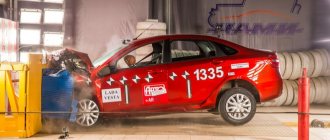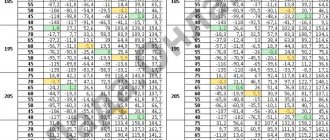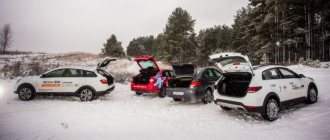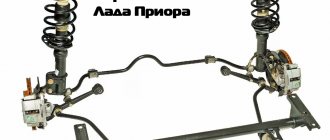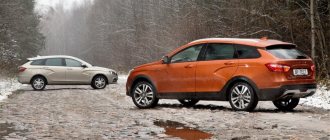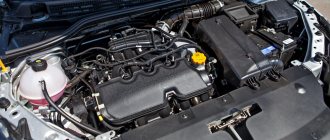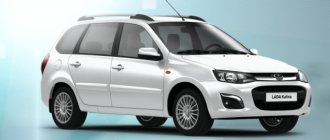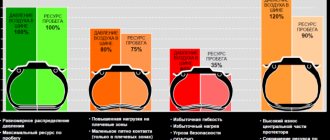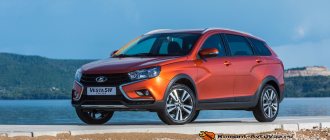Are domestic cars safe or not? This issue causes a lot of controversy to this day, and there are quite a lot of adherents of both one and the other point of view. Everyone is trying to prove that they are right, and after the appearance on the market of new cars from AVTOVAZ - LadaVestaLada and LadaX-Ray, the question has become even more relevant. Information about vehicle safety was collected based on a crash test of station wagons. Under what conditions the tests were carried out, what kind of tests they were, and what the result was - read further in the article.
Pre-production testing of LadaVestaCrossSport
Even before serial production of cars started, comprehensive testing began. It was the month of May 2021. One of these tests was attended by analysts from Autoreview, an authoritative publication trusted in the automotive world. Then the car was tested during a side impact on a ram weighing nine hundred kilograms, there was also a removable tip, and the speed was 50 km/h.
The test vehicle was the most fully equipped car, which contained four airbags. The result exceeded all expectations, and the AVTOVAZ designers were proud of it. Most of the impact energy was absorbed by the threshold, the performance of the side airbags fully met expectations, and the rear windows were not damaged in principle, which cannot be said about the driver's window.
AVTOVAZ reports say that the sensors attached to the driver’s dummy did not detect excessive load. According to HIC (hydrogen induced cracking) standards, which indicate head trauma, a good result was obtained. One Autoreview expert noted an interesting feature. The manufacturer did not test the Cross station wagon version with the luggage compartment loaded, although such a test would seem necessary. Such a test would show how securely the oversized luggage located above the window line is fixed. AVTOVAZ explained why they decided not to conduct such a crash test on the Lada Vesta Cross sw. The reason lies in the very purpose of the car, because it is not designed to transport goods, but is an SUV that has increased cross-country ability, but nothing more.
The package does not include rear side airbags; even if we consider the most expensive, top-end versions, the cabin will only have side airbags in the front row. This was explained by the fact that the final assessment of testing according to EU standards will not change in any way due to their presence, unless the corresponding active safety systems are installed in the car. According to many experts, those who purchase top-end versions would not mind paying a little extra for additional rear row protection.
Other tests
Naturally, crash tests are not the only tests for the Lada Vesta. In addition to the car’s resistance to frontal and side collisions and the operation of protective systems, the electronics embedded in the car’s interior and the chassis of the basic configuration were also tested.
Indeed: the results of the Lada Vesta crash test did not show the presence of deficiencies in the car's suspension system (which, however, were eliminated after unsatisfactory test results). Also, the crash test of the Lada Vesta could not reveal the presence of defects in the operation of the exchange rate stabilization system - it continued to limit the speed of the car for some time after the final exit from the turn.
For all other points, for testing of which almost half a thousand brand new cars, fresh from the assembly shop, were allocated, the tests of the Lada Vesta showed quite satisfactory results. Today, according to the general director of AvtoVAZ, the car’s safety level is 95% according to the world quality standard. Considering the rather low cost of Vesta compared to foreign cars of the same vintage, this level of quality of the new generation of domestic cars threatens to push both Western and Japanese cars out of the Russian car market.
Crash test Lada Vesta SV cross – production version
As soon as sales of the car started, station wagons, which were classified as production models, were tested. To assess the consequences of a frontal impact, the ARCAP method (frontal collision with an obstacle at a speed of 64 km/h) was used, and the test was carried out by representatives of the Autoreview publication. A test of the consequences of a side impact was carried out on a specially equipped territory of the AVTOVAZ plant. Repeated full-cycle tests were necessary, since both the ground clearance and weight of the production car had increased.
Impressions from the Lada Priora test drive
The Priora is often found on city streets, which means it is not in vain that drivers choose it.
Unlike other models of the Lada family, Priora is a city car in which you can go to the countryside. And the car body is selected based on the driver’s preferences. The Lada Priora station wagon is suitable for a family man, and the hatchback and sedan are suitable for a young driver. A test drive of a Lada Priora station wagon with experience in using the car by domestic car enthusiasts gave feedback that the car is roomy and strong. The Priora sedan (as well as the hatchback) showed the same thing, except for one thing - they do not have such a reinforced suspension as the station wagon, and the rear part does not weigh as much, the driving impression changes.
Vesta Cross frontal impact test
Representatives of “Autoreview” purchased a car specifically for testing for 798,000 rubles, which ended up being badly damaged. To assess the consequences, it was necessary to organize a frontal collision with deformable ceilings, speed – km/h. Even before the start of the procedure, specialists noted the presence of large wheels, which is a clear advantage of the car. The top version of the Cross station wagon is equipped with 17-inch wheels, but the sedan can only boast 15-inch wheels. Experts measured the mass of the car, it turned out that it weighs 148 kg more than the sedan, so energy absorption was expected to be 13% more.
Specialists from the manufacturer’s plant were also invited for testing. The first impression after the collision was that the car withstood it perfectly. Due to the additional amplifiers, there was no displacement of the front pillar, and excellent performance of the left spar was noted - it turned out to be folded, and this made it possible to absorb a significant part of the impact energy. One of the alloy wheels cracked from the energy, but also took part of the impact. The excellent work of ERA-GLONASS is noted; almost instantly after the collision, a company employee got in touch. There was virtually no effort required to open the driver's door, and the airbag deployment was also excellent. The table shows what damage the mannequins in the front row received:
| Head and cervical injuries | None. Norm. When the car bounced off during the collision, the driver's head turned, but without any damage to his health. |
| Knee injuries | A slight impact of the right knee on the dashboard, no contact of the left knee with the plastic is noted |
| Damage to the chest compartment | None. The seat belts worked well, the compression force was assessed as normal. During the collision, the steering wheel moved away from the person by thirty millimeters |
| Foot injuries | None. The pedal assembly has moved slightly, but there is no danger to health. |
According to the results of this testing, the car is resistant to frontal impact and received a high score. However, if you test a car according to the progressive European methodology Euro NCAP, the result is not so good, since it is also necessary to evaluate the structural integrity of the passenger seat in the cabin. After removing the decorative plastic that covers the area of the sills and wings, a number of creases in the metal of the rear and front sills are clearly visible. It is known that since 2016, the plant has modified the front sills in cars using thicker metals. Representatives of Autoreview decided to cut the threshold and remove the external linings - as it turned out, the deformation also affected the power unit itself.
After that, we decided to start removing the floor sound insulation, under which a torn floor appeared, that is, the legroom was destroyed, and this is already a reason to deduct one point. The ruptures occurred exactly at the points, but there were no complaints about the welding. Consequently, the sheet metal supplied to AVTOVAZ is not of sufficient quality. The floor of the car under the driver's seat was also deformed, it was raised, and this was an excessive load on the shin area. As a result, the crash test of the Lada Vesta SV Cross actually failed - it earned only a satisfactory rating. The maximum score was 16 points, and Vesta got only 11.7. Minuses were received for the following reasons:
- The lower legs are not sufficiently protected.
- The floor is deformed, according to Euro NCAP standards, this indicates that the doorway is not stable.
- The threshold broke and the dummy hit the plastic steering column. Although it is not dangerous, the plastic covers a number of metal components.
The car was given only three stars.
Insurance test
This type of crash test, also called the Danner test or the bumper test, consists of a car colliding with its front side at a speed of 15 km/h with a non-deformable barrier that imitates the bumper of a standing car.
The AutoReview publication conducted an insurance test for the Lada Vesta in the passive safety laboratory at the Dmitrovsky test site to demonstrate the consequences of a typical accident in urban conditions involving a sedan.
A Vesta at a set speed of 15 km/h with ballast weighing 50 kg in the trunk was collided with a stationary obstacle simulating a bumper, blocking the front of the sedan on the left by 40% and located at an angle of 80 degrees to the axis of the car.
The purpose of this test is to show how serious it will be for Vesta and how expensive it will be for the car owner to repair after a minor accident in the city, when the car “catch up” with the car in front or run into a standing one - the safety of the car also has an economic component. Based on the results of the bumper test, we compiled costing of repairs in official and regular auto repair shops.
Damage during an insurance crash test
After the impact, the driver's door opened absolutely freely, the hood was opened with little effort, but without improvised means, no leaks of working fluids were observed.
The bumper is destroyed, and its restoration is impractical - only replacement. The broken left headlight moved back and slightly crushed the front part of the fender, and the upper front cross member under the hood also moved towards the engine.
Oddly enough, the radiator grille was preserved intact, except for one latch, and its upper mount was torn out of place.
At the same time, the radiator itself is not damaged, only the honeycombs are slightly crumpled, which indicates that its brackets are designed to be torn while preserving the unit itself.
The transverse front beam is deformed, the left supporting part is crushed almost to the maximum, but the geometry of the side members is not broken, which also indicates that the Lada Vesta uses the method of shock-absorbing deformations incorporated into the design.
The beam has no welded joints with the spar, so replacing it will not weaken the rigidity of the elements due to heating during cutting and welding.
Repair costs
Repair of the described damage to the Lada Vesta from an official dealer will cost the following amount:
- repair and restoration work - 40 thousand rubles;
- spare parts and components – 70 thousand rubles.
Total – 110 thousand rubles. with a 1 month wait for parts to arrive.
At a regular car service center, the cost of restoring Vesta will be:
- work - the same 40 thousand rubles;
- spare parts – 20 thousand rubles.
Total – 60 thousand rubles.
The fact is that the official dealer planned to restore only the front left fender, the remaining damaged parts were to be replaced with new ones. And during repairs at a regular service center, you would only have to buy a new headlight, crossbar and chrome bumper trim. All other parts were planned for restoration.
If we analyze the cost of similar repairs of foreign car brands in relation to the cost of a new car, we will get the following picture.
The conclusion from the comparison of ratios is that repairing Lada Vesta at universal service stations after the expiration of the warranty period is more attractive compared to the situation with restoring foreign cars.
Crash test Lada Vesta
On January 15, 2021, the AutoReview publication crashed this sedan for the first time as part of a safety study (Arcap program).
The key conditions of this test, the results of which examine the so-called car cage and the deformations of the mannequins, are:
- speed – 64 km/h;
- overlap with a deformable barrier – 40%.
They took the preparation of the conditions for the Lada Vesta crash test seriously - heat guns were even installed on the catapult trajectory so that the temperature of the dummies was an optimal 20 degrees, which was unrealistic in the frost of minus 16 outside.
At the same time, the functionality of the Era Glonas system was tested in the conditions of a traffic accident, and 10 seconds after the collision, the service dispatcher got in touch and asked what happened.
Having received information about the situation, she reported awareness of the coordinates of the testing site - a test site on Dmitrovskoe Highway.
The first thing that attracts attention in a car after an impact is the windshield that remains above the crumpled front end. We are not talking about the quality of this element, but about the fact that the displacement of the left front pillar as a result of the impact was so insignificant that the deformation was neutralized by the sealing rubber of the windshield opening.
The integrity of the windshield indicates that the volume of the Lada Vesta cabin did not undergo significant deformation changes as a result of testing.
A visual inspection of the sedan initially gave hope that, based on the results of processing electronic strain sensors, Lada Vesta would be close to the leader of such tests - Volkswagen Polo.
How AVTOVAZ reacted to the test results
The engineers were really puzzled by the results; they decided to buy back the car that was broken during testing in order to examine it, since there was a possibility of defects during the assembly process. However, this option was not confirmed. Then they carried out computer modeling and compared the test results at the plant site and the result of the Autoreview test. It turned out that the reason for this behavior of the car in a collision was ballast. There is an algorithm for preparing a car for testing.
| Weight on front seats (dummy weight) | 88 kg each |
| Indicator of tank fullness with gasoline (gasoline is replaced with water) | 90 % |
| Ballast weight on the rear seat | 32 kg |
| Weight in the luggage compartment required for testing the equipment | 36 kg |
When testing was carried out at the factory, 2 child seats and 2 child dummies were installed on the rear sofa, but in the external test they used metal ingots that were screwed to the floors. The weight of each ingot is 20 kg. Permission to use this approach is given by Euro NCAP standards only when there is a guarantee that it will not affect the test results. A mathematical model was created, and engineers found that the use of two ingots, each weighing twenty kilograms, affected the load on the reinforcements and welds, increasing it by 20%. That's why the floors were deformed.
After this fact was clarified, 2 similar procedures were carried out using metal ingots, and the result was consistent with that. What did the representatives of Autoreview receive? But test 3 was carried out with child dummies, and it gave excellent results. Here we note the excellent work of the belts, the absence of folds in the floor, the metal and welding firmly withstand impact. It turns out that if 2 child dummies had been seated in the car, it would have received almost 15 points instead of 11.7. However, the test results prompted the designers to seal the floors, and they succeeded.
Lada Kalina crash test: what did the dummies say?
But the fact that everything is in order with the silt frame of the body is still half the battle.
A little later, specialists deciphered the information from the sensors that were installed on the mannequins. And it became clear why the manufacturer was so sad and sad when looking at the Lada Kalina crash test. The dummy hit his head on the steering wheel with great force, which shocked the testers.
And what’s worse, in the three saving milliseconds that, according to doctors, are needed to ensure that the overload does not affect the human brain, the pressure on the mannequin was twice as high as permissible. These figures are several times higher than those of a foreign car similar to Kalina. Experts have dispelled any remaining doubts that the mannequin suffered a brain injury incompatible with life. Because the injury rate was doubled. Such a sad outcome of the car test. Even when testers conducted tests with Slavuta, its results were lower, and a person involved in an accident had a chance to survive, but in our case there is none.
The minimal injury the dummy suffered during the test was a concussion. Moreover, considering that a mannequin and a person are very different. Indeed, in a real emergency situation, a living person, and not a dummy, will hit his head on a hard plastic steering wheel, and therefore the results will be truly disastrous.
And these are not all the negative factors that this car has. When the dummy who was sitting behind the wheel hit his head on the steering wheel, his head was thrown back so that the sensor located on the cervical vertebra recorded that two out of three parameters were exceeded, the spine was stretched due to the fact that a strong bending moment acted on it. And the severely deformed chest of the mannequin will complement the picture of the injury. The deformation was 50 millimeters. This mark is exactly in the life-threatening zone.
Considering all this, the low load on the knees and shins is pleasing, and it is also pleasing that the pedals have moved only a little, which means that foot injuries have been avoided, but still these characteristics are too few, the overall impression is already spoiled. Although this is also very important. Exactly the same as the fact that the dummy in the passenger seat did not receive any dangerous injuries - he hit his head on the front panel. But still, speaking about the seatbelt passenger of this car, to say that he does not risk getting injured is to say nothing, because the tilt of his head upon impact reaches a critical point, and his chest is also deformed from the fact that he pressed hard on it seat belt, but this injury rate is not too high. A person in such a situation would probably suffer a couple of broken ribs.
Crash test of Lada Vesta Cross during a side impact
Again, the test result is influenced by the evaluation criteria, as in frontal collisions. Side impacts were already tested at the manufacturer’s premises; we took the top-end version of the station wagon. He will participate in a collision with a cart that weighs 950 kg, has a crushable barrier, and speeds 50 km/h. The central part of the car was chosen for impact. The manufacturer talked about a side cushion that was sewn into the seat backs; in the event of a collision, it should open up, cover the window opening by almost half, and the protection will affect not only the body, but also the head.
After the collision, ERA-GLONASS representatives contacted the car 27 seconds later, which is very prompt. Given the shift in the center of gravity closer to the front, a slight turn of the stern was expected. The driver's window was completely broken, but the rear windows and mirror were not damaged. The chief engineer personally expressed his impression of the test, calling it a success. He noted the timely opening of the side airbag, while experts began assessing the damage in the cabin, recording the forces when opening the doors and other analyses. Only after this they begin checking the condition of the mannequin. When the project was just being worked out, AVTOVAZ employees decided to strengthen the thresholds, because the car’s ground clearance had increased, so it was the threshold that would have to absorb the impact energy. Only with the help of reinforcement could it be possible to minimize the effect of the threshold on the central pillars and the likelihood of their displacement. This was a successful crash test of the Lada Vesta Cross - the video is clear evidence that there were no problems opening the doors after the collision, gasoline did not spill out of the tank, and the dummies did not receive serious injuries, especially since even a tool was not needed to remove them. The battery was intact, there were no dangerous parts in the cabin, and according to the injury criteria, they were all below the threshold standards. The manufacturer does not yet plan to test the car with a full luggage compartment or heavy loads, considering this not so necessary. It is important to note that the European Union already has stricter assessment standards, and Vesta was tested according to standards that were developed back in the eighties. For example, using a cart weighing 950 kg is considered irrelevant. Since almost all modern cars weigh more than a ton. According to the Euro NCAP standard, the weight limit is 1 ton and 300 kg, but the assessment standards are the same.
Crash test of the Lada Largus car
The testing scenario for the Lada Largus Cross, which was carried out at AvtoVAZ’s own test site, involved several stages:
- A frontal collision involving a 40-degree shift in the direction of impact. By this, the test participants sought to simulate the impact of a frontal nature that occurs on the oncoming lane of the highway.
- Side impact, which can often be observed in reality when a car collides with a pole.
- Hit to the rear. Here, a car standing behind appeared as an obstacle.
The progress of this test complied with the regulatory aspects outlined in the UNECE Uniform Guidelines. The entire list of standards is indicated in paragraphs: No. 94, No. 95 and No. 34.
DIY armrest for Largus
Replacing timing belt Largus 16 valves
Roof rack Largus
Compared to the testing requirements according to the NCAP system used by European manufacturers, this regulation is characterized by “softer” standards. For example, the procedure for simulating a frontal collision in Europe assumes a preliminary speed of 64 km per hour, but in AvtoVAZ testing conditions this speed is only 56 km per hour.
Attention! For the subsequent sale of Lada Largus on the domestic market, these crash tests are quite sufficient. To gain access to the European markets, you will need to perform the entire list of tests again, while adhering to the requirements of the NCAP standard.
How are the tests carried out?
According to ARCAP, the crash test is a frontal collision of a car at a speed of 64 km/h with a deformable barrier that simulates the front of a passenger car using aluminum particles. Statistics show that direct collisions are rare, so testing involves hitting the car with an obstacle from the front. Where is the driver? The established overlap size is 40%. This is the ability to simulate an offset, head-on collision between two vehicles having almost the same mass.
Total speed – 110 km/h. 2 mannequins are seated in the cabin, and with the help of sensors installed on them, information about the overloads that act upon impact on such parts of the body as the head, lower leg, chest, kneecaps and hip area is recorded. They examine information on the driver and front row passenger, calculating what injuries they may receive. And with what probability? The calculation takes into account the movement of the steering wheel, the shift of the front left pillars and pedals. Such testing is possible at AVTOVAZ in the Russian Federation, as well as in the Czech Republic, thanks to the specialists of TÜV SÜD Czech
Lada Vesta Cross safety level
If we evaluate the test result according to the criteria of the Russian plant with child dummies, then it turned out to be simply excellent. There are no floor breaks at the welding points, the thresholds are not swollen or broken. Experts were able to prove that the unsuccessful scores obtained in the external test were due to the fault of Autoreview representatives. The use of twenty-kilogram ingots affected the final results, as they increased the load on the floors. When testing at AVTOVAZ, Vesta SW Cross was able to receive not only 14.9 points, but also a maximum of 4 stars. The car has high safety scores, more than the Lada Kalina, which scored only 10.1 points, and the Grant with a score of 10.7 points.
